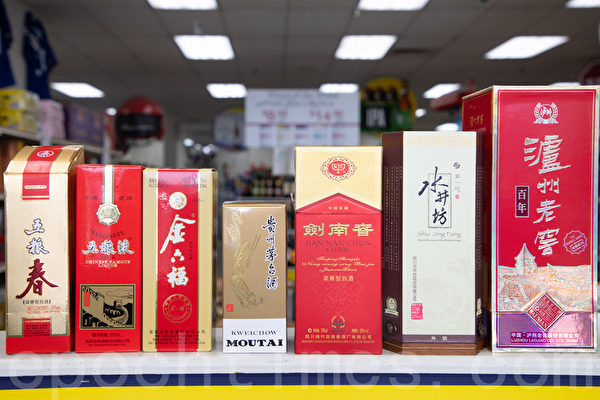Recently, the three major Chinese liquor giants with prices above 1,000 yuan (RMB, Chinese currency) have all dropped below that benchmark, marking a significant shift in the high-end liquor market. Maotai 1935, Wuliangye, and Guojiao 1573 under Luzhou Laojiao have long dominated the high-end liquor sector in China. However, the prices of these top three liquors have all dipped below the 1,000 yuan mark. Even the prestigious Maotai brand, known for its high market value, has seen its prices drop to around 2,000 yuan per bottle.
According to a report from Wall Street Observer on May 26th, Chang Le, the owner of a tobacco and liquor wholesale and retail store in Chaoyang District, Beijing, stated, “The 8th generation Wuliangye can be sold for as low as 940 yuan, Guojiao 1573 can go for 900 yuan per bottle, and Maotai 1935 can be sold at 700 yuan per bottle.”
Chang Le mentioned that the market has been sluggish this year, with prices failing to pick up. Approaching the Dragon Boat Festival, liquor consumption has shown little excitement.
In Zhengzhou, Henan Province, prices at a famous liquor specialty store are even lower. Zheng Zhi, the store owner, mentioned, “Even for high-end liquors, profits are very slim.” The 8th generation Wuliangye retails for around 930 yuan, Guojiao 1573 for around 860 yuan, and Maotai 1935 is as low as 690 yuan per bottle.
Similarly, prices in various manufacturer-owned specialty stores are below 1,000 yuan. Multiple Wuliangye and Guojiao specialty stores have indicated that the 8th generation Wuliangye retails for around 980 yuan, and if bought by the case, it amounts to about 950 yuan per bottle; Guojiao 1573 retails between 940-980 yuan, and buying by the case lowers the price by around 20 yuan per bottle.
The owner of a Guojiao 1573 specialty store in Beijing mentioned, “Since we are directly supplied by the manufacturer, our prices may be a bit higher, but quality is guaranteed. I make a profit of 30 yuan on each bottle of high-end Guojiao.”
However, the official recommended prices from the distilleries paint a contrasting picture. The standard 500ml bottles of the 8th generation Wuliangye and Guojiao 1573 are recommended at 1,499 yuan and 1,399 yuan, respectively, while the Maotai 1935 with 53% alcohol content is officially priced at 1,188 yuan per 500ml bottle.
Despite these high official prices, numerous small tobacco and liquor stores dotted around communities and streets reflect the true market prices.
The decline in prices of liquors above 1,000 yuan directly encroaches upon the market share of products priced between 800 and 1,500 yuan, which belong to the second-tier high-end category. Consumers are more inclined towards “downgrade consumption,” opting for high-end Maotai and Wuliangye liquors over second-tier products, leading to further contraction of the regional famous liquor market share.
Moreover, due to the market turmoil, upstream distilleries have begun cutting production or even halting it altogether. According to a report by Cover News, in Maotai Town, the production hub of sauce-flavored liquors, 70% of small and medium-sized liquor enterprises have halted production, and the price of raw liquor has plummeted to below 30 yuan per half kilogram.
A prominent figure in a local liquor enterprise stated that since the beginning of this year, around 70% of the production capacity in Maotai Town and its vicinity has ceased, with over 30% of business development managers transitioning to other fields. Many financially weaker small and medium-sized distilleries without advanced production orders from larger companies generally do not produce but operate on a per-order basis. Once production starts in a factory, it cannot be easily halted within a year, making it financially burdensome for many smaller distilleries, thus forcing them to shut down.
Simultaneously, prices of sauce-flavored liquors in Maotai Town have plunged significantly. An entrepreneur from a local distillery remarked that in Maotai Town, the price for Kuns ha sauce-flavored liquor has dipped to below 30 yuan per half kilogram, a stark difference from a few years ago when it was nearly impossible to find it for less than 200 yuan per half kilogram.
A seasoned industry expert pointed out that the small and medium-sized distilleries in Maotai Town may never be able to return to their past glory, and many may face permanent closure.
Since last year, the Chinese liquor market has been continually sluggish, even witnessing underwhelming sales during the highly anticipated peak sales seasons of the Mid-Autumn Festival and Chinese New Year. Following the Chinese New Year, a phenomenon of retail prices falling below factory prices (price inversion) emerged in the Chinese liquor market, prompting several distilleries to implement supply stoppages as a “shock therapy” to stabilize market prices.
Reported by Financial Sector, from January to February 2025, over 10 leading liquor companies in China issued 16 notices to stop production, covering a range of products from the upscale line like the 8th generation Wuliangye (Pu Wu), Mengzhi Lan M6+, and Xijiu Cellar 1988 to the second-tier and mid-range including Yanghe Tianzhi Lan/Hai Zhi Lan, Today and Forever Guoyuan Four Openings/Double Openings, Fenjiu Blue Flower 20, and even base-priced liquors like Luzhou Laojiao Old Head Qu and Lidu Sorghum 1955. This supply-stoppage trend has encompassed liquor products from as low as 100 yuan to upscale products exceeding 1,000 yuan.
Industry insiders attribute the severe market turmoil in the liquor industry to excess production capacity, shrinking consumer demand, and soaring inventory levels.
Regarding the future of the liquor market, Kaiyuan Securities believes that the industry’s true recovery will depend on inventory cycle clearance. This adjustment not only involves restructuring the price system but also challenges liquor companies to break free from the cycle of “pressure sales-stoppage sales.”

